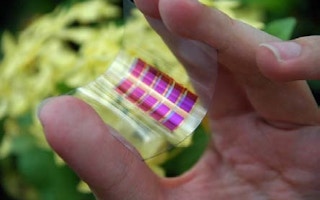A new material developed by a Singaporean science research institute has been hailed as a breakthrough for both the electronics and thin-film solar manufacturing sectors.
Singapore’s Institute of Materials Research and Engineering (IMRE) announced on Tuesday in a press statement the new plastic, or polymeric material, would pave the way for the large-scale manufacturing of printed electronics and organic solar cells, and open up new design options for electronic and solar cell companies.
Printed plastic electronics and organic solar cells are made by printing carbon-based solutions onto a surface to create semi-conductors.
Today most semi-conductors are made through an intensive manufacturing process that involves etching circuits onto an inorganic silicon surface in a carefully controlled cleanroom environment. The process is lengthy and resource-intensive.
IMRE argues that creating a single bulk resource material for use in printed electronics and printed solar cells – the polymer can be used in a roll-to-roll printing process similar to the way newspapers are printed large spools of paper – could revolutionise both industries by lowering costs and accelerating production.
Polymeric materials are not new to either industry: they are studied widely for potential applications in both the electronics and the solar cell industries because they can be used as lightweight, flexible, cheap and disposable products. In neither sector do the materials perform as efficiently as traditional materials used in semi-conductors.
But scientists at IMRE believe they have hit on the right combination of materials to increase the performance sufficiently within both sectors to push the technology into wide-spread commercial use for devices that need both the power-harnessing capabilities of solar and the conductivity of electronic circuits.
“Current polymers are usually good in one aspect or another, either as a good conductor for use in electronics or endowed with high power conversion efficiency - but not both,” said Dr Chen Zhi Kuan, the principal IMRE scientist working on the polymers.
“IMRE’s polymer functions not only as a good material to make electronic components, the same material can be used to convert sunlight to electricity efficiently,” he added.
IMRE said its polymer achieves the same conductivity as current commercially available semiconducting materials and it has significantly improved upon the solar power conversion efficiency of similar materials. The polymer can convert 6.3 per cent of solar power into electricity, compared to the 2.2 per cent conversion from other polymers in the same class.
In January, the National Renewable Energy Laboratory (NREL) in the United States announced that Massachusetts solar research firm Konarka Technologies attained a power conversion efficiency of 8.3 per cent for its polymer based solar cells. Solar conversion efficiencies in silicon solar cells can reach 20 per cent.
“This breakthrough will help speed up the development of plastic electronics and organic solar cells, and make them more readily available in the marketplace,” said IMRE executive director, Professor Andy Hor.
Products based on plastic electronics include disposable electronics, retail security sensor tags, flexible display devices such as electronic banners and e-paper, and smart packaging (such as packaging capable of detecting expired food items). The carbon-based materials do not pose the same hazardous waste problems as traditional electronics, which can add heavy metals to the waste stream.
With the development of IMRE’s solar-friendly polymer, such products can power themselves through embedded solar cells.
Additional research into printing solar cells was recently announced by the Australian Government. Through a government-funded ‘Clean energy future’ programme, researchers at the University of Melbourne, the CSIRO Future Manufacturing Flagship, and Monash University will work with private sector companies on a AUS$7.2 million project to commercialise solar printing technologies.
Australia’s Minister for Resources and Energy, Martin Ferguson, who launched the project in Melbourne last month, said in a statement, “This collaboration between researchers and industry partners will help commercialise the technology across a variety of potential applications, including for example as a coating for other material such as roofing steel.”
The industry partners involved in the project are Australia-based BlueScope Steel, British-headquartered industrial film manufacturer Innovia Films and German technology firm Robert Bosch.
The hunt for the perfect polymeric materials isn’t over. A research team at US based Harvard University has tapped into the vast resources of IBM’s World Community Grid to methodically inspect millions of possible molecules for more efficient energy conversion.
The World Community Grid uses idle computer time donated from the personal computers of volunteers to speed up projects that require complex computer modelling, such as a research programme to discover which molecules interact best with water for more efficient water filtration. The use of computer modelling to reduce the time needed for laboratory research is an established method in the pharmaceuticals industry.
The aim of the Harvard project, called the ‘Clean Energy Project’, is to find materials with an energy conversion efficiency higher than 10 per cent. The team has screened 2.3 million molecules to date out of a planned 3.5 million. An article published this week in NatureNews.com notes that the project has produced promising compounds, which are being laboratory-tested at Stanford University.
Meanwhile, researchers in Singapore, Australia and other countries are eager to move forward with the commercialisation of printed electronics and solar products.
“Using low-cost and readily available organic materials to print solar cells through established industrial processes where we already have a competitive advantage offers the potential for solar cells to be manufactured at low-cost in Australia,” said Mr Ferguson.

















